|
Friend or Foe: The 'Evolution of Military Aircraft
Identification Insignias
By Hersch Pahl
Through out the ages, warring forces have devised ways to identify themselves from the enemy -- "friends
or foes." The insignia used by the U.S. combat forces is definitely an "item of interest" as it
had to be changed or adjusted several times during WW-II to improve aircraft identification.
This document is not intended to be an official record of the evolution of design changes in our
insignias; rather, it is the story of events and situations that I recall which influenced some of the changes
in the design.
Butch O'Hare in his F4F Wildcat following his famous five
plane shoot-down victory in Feb 1942. Photo shows insignia on left wing with Red Ball in center of a five point
white star in a blue field.
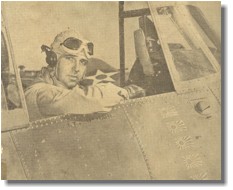 |
December 7, 1941, when WW-II began, we were using a big round blue circle enclosing a white five
cornered star with a red ball in the center. This was in use in February, 1942 when Butch O'Hare (VF-3) shot down
five enemy aircraft on a single mission over the USS Lexington (CV-2).
F4F Wildcat's on Flight Deck readying for a combat mission
to Marcus Island Raid showing the Red Ball in a Five Pt. Star within a blue field.
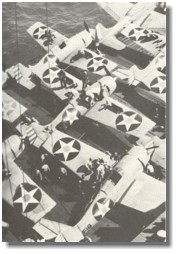 |
March 4, 1942 USS Enterprise (CV-6) struck Marcus Island using F4F-3 fighters with an extra large blue circle with white star and red
ball in the center.
April 18, 1942 The Doolittle B-25's were launched from the USS Hornet (CV-8) for the raid on Tokyo displaying the White star on the blue circle.
The Photos of B-25's taking off from the HORNET appears to confirm that the red ball was still being used within
the white star at that time. If you Look closely at fuselage Insignia (Left Photo) and under the wing in the photo
to the right you will see that this is a fact. There had been some thought that the red ball was no longer in use
by the Doolittle Raid date.
Photos are USN Photos courtesy of NavSource Naval History Web Site - USS Hornet CV-8 Page with gratitude to the U.S. Naval Historical Center for their use.
Insignias on Lt. Col. Doolittle's B-25's
confirms the Red Ball was still in use, which dispels rumors to the contrary.
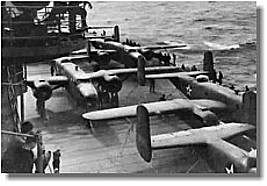 |
|
|
Lt. Col. James H. Doolittle (left front) chats with the Hornet's
C.O., Capt. Marc A. Mitscher, USN, after giving his Flight Crews a Pep-talk just before their historical mission
on 18 April 1942, to bomb the Japanese homeland.
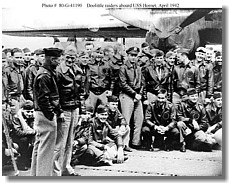 |
|
May 1942 - While Butch was back in the states receiving the Medal of Honor from Franklin D. Roosevelt,
and selling bonds, the LEXINGTON became involved in the Battle of the Coral Sea and was sunk.
June 2 - 6, 1942 - Next we became involved in the Battle of Midway. Jimmy Thatch was in command of
VF-3 as they flew from the USS Yorktown (CV-5).
His F4F Wildcat fighters and the SBD dive bombers were using the big white star in a blue circle
for an insignia. The red ball in the center was definitely gone.
F4F Wildcat Fighters on the way to the Battle of Midway under
Command of Jimmy Thatch Click on Photo to reveal Aircraft Insignias used at this time.
|
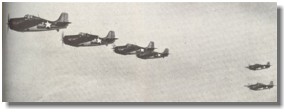
|
A Formation of SBD Dauntless Dive Bombers showing the Star
insignias without Red Ball.
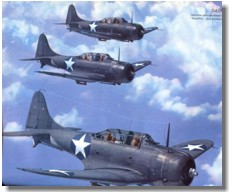 |
The U.S. used the insignia as showin in the above photo of the SBD Dauntless from the time WWII began
until after the First carrier raid on Wake Island in Oct 1943.
F4F readying for take-off on Ranger CV-4, November 1942, showing
Insignia
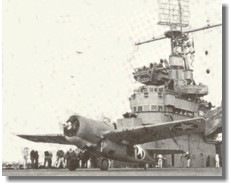 |
In November of 1942, the USS Ranger CV-4 became involved in the Invasion of North Africa. The F4F Wildcats were marked with the white star
on a blue background; however, the blue circle had a red border around the whole insignia.
Later while the Ranger was transporting Army P-40 Warhawk fighter planes to Africa. The planes displayed
the American flag painted on the side next to the white star on the blue circle.
P-40 Warhawk fighter planes being hoisted up to the deck of
USS Ranger CV-4. This photo shows the insignia being used that time.
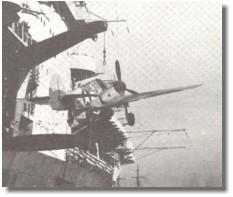 |
Some guys seem to think that the Red Ball by this time was
still being used. This photo during the Marcus Raid shows otherwise.
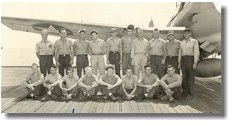 |
Approximately 11 months later in September 1943, when the 3 carrier task force (Independence, Yorktown
and Essex) made a raid on Marcus Island, we used the big white star on a blue background with a white bar through
it and a narrow red frame around the whole thing - as shown in the photo taken of a VF-6 Hellcat on the Independence
a few days after the raid. At a photo-op on 9/6/43 on the way back from Marcus the photo of the crew in front of
one of our hellcats shows the insignia used at Marcus.
A short time later on 14 and 15 October 1943, we struck Wake Island with a multi- carrier task-force.
Butch O'Hare was embarked on the Independence CVL-22 with three VF-6 divisions while George Bullard was riding
the Cowpens CVL-25 with his three divisions and Paul Rooney was aboard the Belleau Wood CVL-24 with the other three
divisions of VF-6.
Our forces got into big trouble Early on the 14th of October '43, when they had some difficulty distinguishing
friend from foe. Even though the insignia had been adjusted before the Marcus raid in September '43 by adding the
white bar through the circle and adding a red frame around the whole thing, some confusion was experienced by our
forces at Wake.
In more than one instance our VF-6 pilots reported some confusion and told stories of near disastrous
consequences. The first wave of our fighters to strike Wake Island were intercepted over the target by about 30
Jap Zeros, and most of them were shot down.
It was apparent an adjustment in our Insignia
was needed
With the permission of both Sy Mendenhall, and Willie Callan, the following incident is related to
show that some adjustment needed to be made in our insignia.
"Butch" was leading an eight plane flight. Willie
Callan was the wing-man of Sy Mendenhall who lead the second section in Butch O'Hare's division. When Butch's division
encountered a flight of three Jap zeros, there was some shooting going on with both offensive and defensive maneuvering
of aircraft. We know that both "Butch" and Sy shot at one enemy fighter and then in the next pass, "Butch"
flamed him and then continued to shoot down a twin engine Betty bomber while Hank Landry, Ash Roberts and Al Vraciu
each got their first "shoot- downs". George Bullard, in another flight also scored his first victory.
During the maneuvering, or dogfight, Willie and Sy became separate for a short time during which
Willie sighted a plane that he thought was displaying a big shinny "meat ball" and took a shot at it
- only to realize a bit later that it was the Hellcat flown by his leader, Sy Mendenhall. With luck, the quick
snap shot he had taken at Sy only hit his tail.
After the flight, with great embarrassment and with "hat in hand" these two pilots went
to "Butch" with the details of their near tragic and embarrassing story. "Butch" listened intently
for a while and then responded, "Willie, I have been telling you all along that you just are not putting enough
lead on your targets before you pull that trigger"
|
|
|
Willie Callan Left and Sy Mendenhall
 |
|
When the gun camera film from our fighter planes was developed, (one of the few that was loaded with
black & white film) it created more than a little excitement. In addition to showing an enemy aircraft being
shot down, it clearly showed an F6F Hellcat being fired upon. At least two other pilots reported that they too
had mistaken an F6F Hellcat with its big Round US Insignia for the big round ball used by the enemy, with near
disastrous results.
There were other reports of miss identification and "Hank" Landry will always remember
being shot at by another hellcat. Fighter squadrons from the other carriers also reported cases of miss identification.
It will not improve the situation to identify the guys that shot at the wrong planes: however, the point was well
made that something more needed to be done about our insignia.
Further analysis of the problem revealed that the high gloss paint, at least on the star and circle
at that time may have caused the reflection of light from the circle to appear as just one color like that of the
rising sun insignia on the Japanese planes.
Lt(jg) Hersch Pahl stands next to a F6F Hellcat, showing insignia
without the red bar though the white bar.
 |
The photo above shows the insignia when it had a dark frame around it and before they put a red bar
through the white bar. It also shows Lt(jg) Hersch Pahl just after he was awarded his first Air Medal for a shoot-down
at Wake Island October 15 1943.
After they changed the paint and the way it was applied is wasn't long until other adjustments were
made, i.e. like changing the frame around the insignia from red to dark blue and later placing a narrow red bar
down the center of the white bar.
There may have been a few other minor adjustments, but this is basically what we have now.
Willie Callan with crewmen showing
most recent change to insignia on F4D
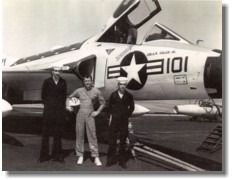 |
|
|
A crewman helps Willie
into his F4D Skyray Fighter
 |
|
Willie Callan with crewman in front of one of his squadron F4D fighters showing insignia. Photo on
right shows Willie being strapped into his fighter ready for takeoff.
|
|
|
Coming in on approach with tailhook down - ready to 'catch
a wire'
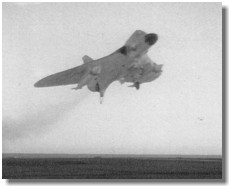 |
|
The photo above on left is Willie Callan in his F4D fighter circling the USS Forestall CVA-59 with
the insignia showing. Photo on right is showing Willie's F4D Skyray fighter with tailhook down, coming in for a
landing. There is no insignia showing, but it is a good Photo of the fighter.
Sy Mendenhall went on to become the commanding officer of an AJ-1 Savage photo squadron.
AJ-1 Savage in Flight
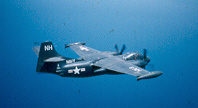 |
Hersch Pahl went on to pilot the AJ-1 during the early Cold War years when he became involved in
the Navy`s nuclear weapon program where he served in a carrier based heavy attack squadron in the Mediterranean
Sea operating from two different aircraft carriers. More information on this can be found here.
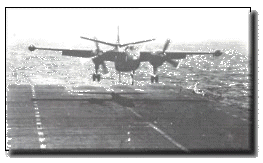
- Hersch Pahl

"For those who fought for it...
freedom has a flavor the protected will never know!"
|